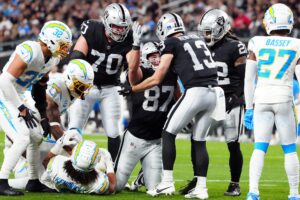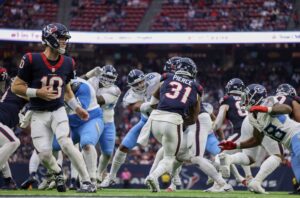Painted in vast array of color, both bright and dull, the Kansas City Chiefs 2017 season was a myriad of frustration. To paint the season as a failure would be dismissing the incredible play of Alex Smith, Kareem Hunt, and Albert Wilson. Failure would dismiss the method Matt Nagy used to repaint the offensive as a beautiful picture when everything was going wrong. At surface level, an AFC West division title at 10-6 is no mere, average wash of a failure. The Chiefs were awe inspiring when they were good, and putrid when bad.
And yet, that putrid taste the team left with the wild card playoff loss to the Tennessee Titans will be what the 2017 Chiefs are remembered for. A more apt adjective than failure would be disappointment. The team left no doubt in successful fronts, but also left no doubt where they were an abject disaster. Fortunately, moving forward there ought to be clear implications for the front office to rework those positions. However, in the moment, those data lines are purely frustrating, reminiscent of that which could have been. The 2017 Kansas City Chiefs stats are poignancy in a data book – a line of fun facts that are fun, but in the end, are meaningless due to the depravity at certain positions.
Here, defense and special teams is the focus. Be sure to check out part one which details key stats on the offensive side of the football.
2017 Kansas City Chiefs Stats – A Book of Average Fun Facts (Defense/Special Teams)
Pass Rush Disaster
The Chiefs defense is built on a ‘bend, do not break’ system. Hence, the corners need help to see the 3-4 defensive front bring exterior pressure with expansive pass rushing. For that reason, former general manager John Dorsey and Andy Reid have put 21.43 percent of the salary cap, roughly $36,626,452 into pass rushing focused units.
Thus, what is the quickest way for the defense to become an utter disaster? The most expensive units fail to bring pressure. The Chiefs got a sack in 12 games, seeing an 8-4 record in those games (2-3 without a sack). In those losses, the Chiefs aligned a mediocre six sacks.
The pass rush did flip the context of when they landed sacks – earlier in the year, the pass rush died in the second half. However, by the end of the year, the Chiefs had 21 sacks in the second half, with 10 in the first half. Jarvis Jenkins (only one sack, but asserted pressure through leverage) and Chris Jones (six sacks) deserve major credit for folding the pocket from the inside out in the second half of the year. However, tying for 24th in the NFL with 31 total sacks, and often failing to sack quarterbacks in the most important scenarios, the Chiefs ought to reevaluate their defensive structure.
What Run Defense?
If the pass rush was boring and vastly below average, then the run defense was even worse. By the end of the season, opposing running backs puncturing the Chiefs core became an expected part of the game. The Tennessee Titans 202 yards on the ground were a direct path to victory.
The defense held opponents to under 100 rushing yards in only five games, allowing 1,890 total yards at 4.3 yards per carry. Furthermore, the explosive plays were egregious, a large influx of why the Chiefs gave up games so awkwardly and quickly. The explosive runs allowed totaled 70; only the Bills were worse at 74 runs.
Why were the explosive runs such a problem? A lack of ability to play proper run-to-fit, Reggie Ragland learning a new system, and Derrick Johnson slowing down were huge factors. Safeties Daniel Sorensen and Ron Parker did clean up in tackles, topping the team at a combined 124. Johnson was third at 48, but Bennie Logan finished ahead of Ragland in total tackles with 35 compared to 31. As a total unit, the secondary saw 52 percent of tackles at 339. Partially acceptable when the front line is charged with getting more push than tackle stoppage, but completely egregious when Sorensen – a safety – is getting to run stopping tackles quicker than Ragland or Frank Zombo.
Bending, Breaking, Please Try to Tackle
The defense was ugly this year – really ugly. Between Marcus Peters erratically throwing flags into the crowd and getting suspended, or Sorensen playing slow, there were moments they looked lost and wholly bereft of purpose. The secondary was equally underwhelming at stopping explosive passes, allowing 56 (20th in the NFL), and often seeing a lack of urgency.
Peters finished with five interceptions and three forced fumbles – there were times his aggressiveness paid off. Then again, there were other times, such as against the Oakland Raiders (Amari Cooper 19 targets, 11 receptions, 210 yards, two touchdowns) or the New York Jets (Jermaine Kearse 10 targets, nine receptions, 157 yards) where receivers torched him and the rest of the secondary.
As a team, the Chiefs allowed the third most passing yards (3,952), the NFL average of 23 touchdowns, and seventh most net yards per attempt (6.6 yards). Holistically, many of those yards did not become touchdowns due to the aggressive turnovers that bounced the Chiefs way – they did finish with 26 turnovers, seventh best in the NFL. Thus, the total points allowed was the NFL average of 339.
The amount of average marks the Chiefs have set summarizes their season. They allowed teams to convert above 39 percent of third downs (the NFL average) in six games, going 2-4. 13 times teams were allowed over the NFL average 20 first downs, a survivable 7-6 mark. The red zone was equally mediocre, with teams scoring 54.9 percent of the time upon entering the red zone (19th in the NFL).
In summation, there were marks of average, there were marks of good, there were marks of pathetic. More than anything, the marks were pathetic, and embodied a team which deteriorated throughout the tenure of a game. Contextualizing the statistics with the tape, and there were plenty of moments tackles were missed, and running backs wound their way through the Chiefs secondary. A total embarrassment where every awful factor was displayed in the loss to the Tennessee Titans.
Harrison Butker!
Alas, the end of the article has come, and leaving off Harrison Butker would be egregious. In the pre-season, Cairo Santos was shaping up to be the Mr. Consistent, until he tore his groin early in the year. When kickers fall off the table, they fall fast and hard. The front office never gave Santos the chance to fall off the table, cutting him and signing Butker.
The following was totally unexpected, but a lovely surprise. Since Butker’s arrival in week three, he made 38 of 42 field goals, accounting for the same amount of field goals as offensive touchdowns, made all extra points, nailed four of five field goals over 50 yards, and made the game-winning field goal against the Washington Redskins. Against the Broncos, Miami Dolphins, and Houston Texans, he made five field goals each, earning AFC special team player of the week for his heroics against the Broncos and Dolphins.
Butker now owns the record for field goals made by a rookie (38), which is also most field goals from a Chiefs kicker, the most points by a Chiefs kicker (142), and the most five plus field goal games in a Chiefs season (three).
Butker also was fourth in the NFL for average kick off length (64.2 yards), helping the Chiefs hold teams to starting at their own 26-yard line on average (third best in the NFL).






